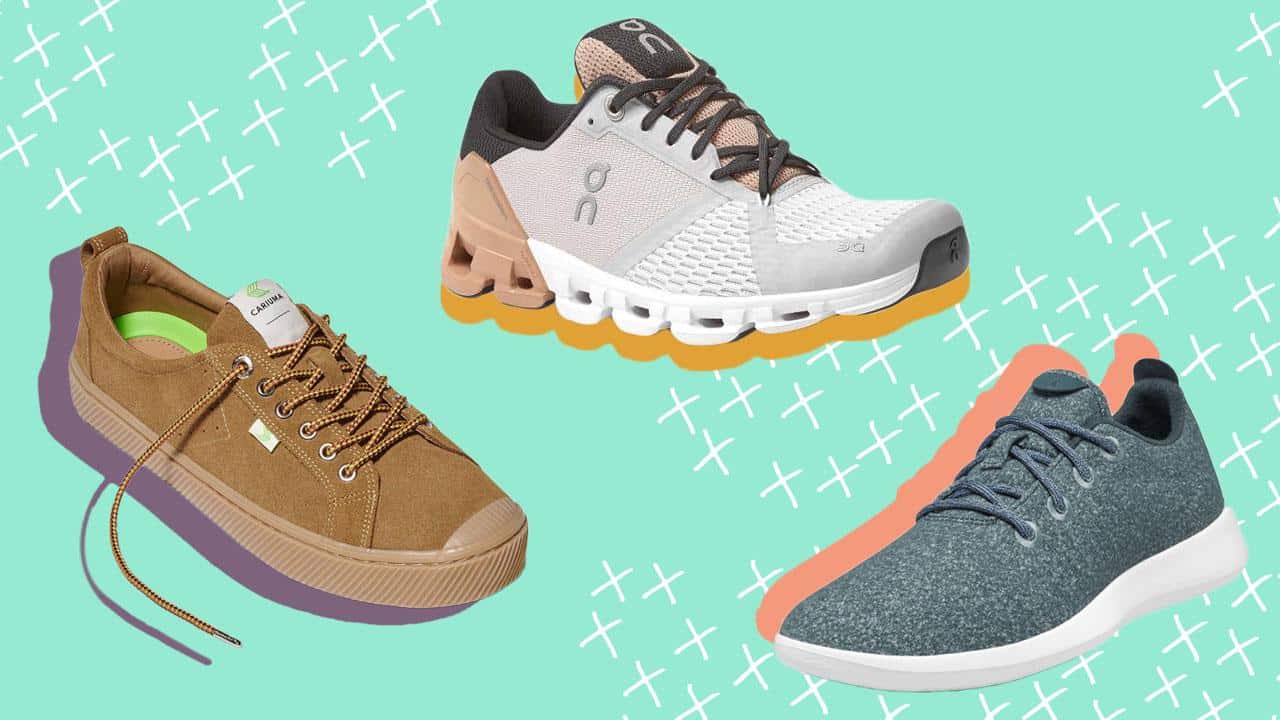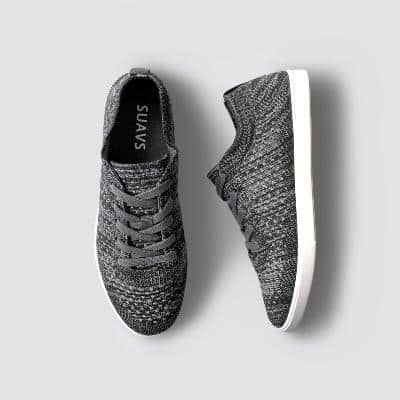

When it comes to finding new shoes to fill your closet, finding something stylish and comfortable is likely the main goal. But shouldn’t their impact on the earth matter just as much? Here is a roundup of the best eco-friendly and environmentally-conscious shoes.
Our picks for top eco-friendly shoes
- Best Recycled Plastic Shoe – SUAVS
- Best Zero-Waste Shoe – On Running
- Best Sustainable Materials – Cariuma
- Best Carbon Neutral Shoe – Allbirds
- Best Clean-Energy Production – Womsh
- Best Vegan Shoe – Beyond Skin
While flipping over a pair of shoes as you shop can tell you about the size of their literal footprint, discovering their carbon footprint isn’t always as easy. That’s because transparency, for many brands, remains less of a priority.
As a result, shoppers don’t always have the clearest vision of how some shoe companies operate—including how and where they source their materials, and who actually puts them together. It’s important to understand that the very practices that led to the mass production of so many classic brands are less than stellar for the environment and the people that actually make them.
How we chose the best shoes for the environment
To create our list of the best eco-friendly shoes, we compared brands on a number of factors. These included:
- Sustainable materials – Does the brand use recycled or sustainable materials to make their shoes? We looked for brands that utilize post-consumer recycled materials, like fibers from plastic water bottles or recycled paper, in their shoes and packaging. We also considered their sourcing of naturally-derived materials, like sugar cane, castor beans, cork, and wool.
- Transparency – How much does the brand tell you about its manufacturing process and materials? We checked out each brand’s website to confirm their commitment to the environment and to make sure they weren’t just green-washing their products.
- Ethical standards – Where does the brand manufacture their shoes and do they ensure fair labor practices? In addition to the environmental impact of a brand’s shoes, we also looked at how they treat their people. We specifically looked for brand transparency and commitments around creating healthy and safe working conditions in factories, and that employees earn fair wages, as well as B-Corp certification.
- Giving back – We wanted to prioritize brands that do more than just make money. We looked for eco-friendly shoe brands that partnered with non-profits to give back, including projects like Soles4Souls, LifeWorks, and reforestation initiatives.
Discover five of our favorite eco-friendly shoe brands that you simply can’t go wrong with. Whether you’re in need of new sneakers, boots, flats, or heels, they’ve got you covered.
SUAVS – The Zilker

SUAVS
SUAVS makes comfortable, breathable, and sustainable shoes with uppers made of post-consumer recycled water bottles. They put the environment first and use only the safest materials that are better for the earth and you. SUAVS makes a point to give back and donates all extra footwear to organizations such as LifeWorks.
Why buy: Planning a vacation? Look no further. SUAVS shoes are known for being lightweight and flexible, allowing for easy packing and all-day wear. Their shoes have been featured in Buzzfeed, Conde Nast, Business Insider, PRNewsWire, and more for being a travel-friendly shoe.
On Running – Cyclon

On Running
Switzerland-based shoe brand On Running is beloved for its performance-based shoes that offer optimal performance without harming the earth in the process. The brand prides itself on sustainability, ethical sourcing, and transparency. They’ve even partnered with the ScienceBasedTargets initiative to ensure they lower their emissions to a level that will support the limiting of average global temperature raising to 1.5°C (34.7°F) above pre-industrial levels.
Why buy: The Cyclon is a revolutionary zero-waste shoe. The sleek shoe is made with sustainable production efforts from castor beans and it’s fully recyclable. The caveat? You can’t own them. Instead, they’re available via subscription to ensure that you recycle them back to the brand. By creating this production process, the brand is able to capitalize on circularity, effectively keeping materials out of landfills.
Cariuma – OCA High All Camel Suede

Cariuma
If you’re a sucker for smooth-as-butter leather sneakers, Cariuma is the choice for you. Namely, the brand’s OCA High Off-White Premium Leather high-top sneakers. Of course, the Rio de Janeiro-based shoe brand offers more than just leather, they sell canvas and suede silhouettes, too. The company is also committed to sustainability, planting two trees in the Brazilian rainforest for every pair of shoes sold.
Why buy: All of the materials used in Cariuma’s shoe-making process are sourced sustainably and responsibly, from the leather and suede uppers and recycled plastic used in the brand’s shoelaces, labels, and laces to the Bluesign-certified dye chemicals (which are non-harmful) and recyclable packaging. As a result of their rigorous eco-conscious efforts, the brand has earned seven sustainability certifications.
Allbirds – Women’s Tree Dashers

Allbirds
Known as Silicon Valley’s most-beloved shoe, Allbirds are renowned for their versatile wool runners that are minimalist, sustainably-sourced, and cozy as can be. The brand is entirely carbon neutral. This means that they measure their carbon emissions each year, reduce their impact by using recycled materials, and offset whatever’s left over by taxing themselves and putting that money toward projects that neutralize their footprint.
Why buy: These Tree Runners are made from FSC-certified eucalyptus trees, a castor bean insole, and a carbon-negative sugarcane midsole. While Allbirds shoes end up being carbon neutral, the company does provide their initial carbon footprint score. These running shoes come in at 9.0 kg CO2e.
Womsh – Vegan Wave White Rose

Womsh
Sustainability meets trendy fashion with Italian shoe brand Womsh (short for Word of Mouth Shoes). The celebrity-favorite sneakers are known for their chunky silhouettes overlaid with bold designs and text. Beyond their truly picture-worthy style, the shoes are created with sustainability at the helm.
Why buy: In addition to creating a fully vegan collection, as well as shoes that are fully recyclable, and producing their shoes in factories that use 90 percent clean energy, Womsh has teamed up with LifeGate to offset its carbon emissions. They do so by planting trees in areas that have been deforested. Since 2014, they’ve planted and protected over 118,403 square feet of forest per year. Talk about impact.
Beyond Skin Nova Cognac Faux Leather Vegan Knee High Boots

Beyond Skin
Sneakers aren’t the only option when it comes to eco-friendly shoes. Since its inception in 2001, Beyond Skin has been committed to providing the world with luxury vegan footwear in the form of vintage-inspired sandals, mules, loafers, heels, boots, and more. All of the silhouettes are designed in England and brought to life in Spain using luxury Italian fabrics. By creating their products locally—as opposed to sourcing all over the world—they’re able to reduce their carbon footprint. What’s more, they use recycled materials in many of their designs, which makes them even more eco-friendly.
Why buy: In addition to paying mind to the materials used, Beyond Skin works very closely with their factories in Spain to ensure their workers are never exploited in the process of production. It is their mission to stand far apart from fast fashion, offering silhouettes that can withstand the test of time—both in terms of wear and classic styles—and practices that benefit the earth and its people.
Why choose eco-friendly shoes and products?
Eco-conscious and eco-friendly are used to describe products made with the earth in mind. In order to create eco-conscious products, a company must commit to sustainable manufacturing practices, the use of sustainable materials, and how much energy is used to create each product. This includes a commitment to use less water and fewer (or, better yet, zero) chemicals in production, along with paying mind to the amount of carbon emissions created as a result of production, the types of fibers that are used, and the quality of life offered to the workers creating the items. In other words, creating eco-friendly items—shoes, included—is a more involved process than is used for most mass-produced goods.
As a result, many earth-friendly brands are marked at a higher price due to the higher level of care dedicated to bringing them to life. The beauty is, however, when more care is devoted to the production process, the higher the quality ends up being. So, while a higher price tag may make you wince, knowing that the items will last much longer and will make less of an impact on the environment is definitely worth it.
Rebecca R. Norris is a writer in the DC metro area. She covers a number of topics in the sustainable beauty, wellness, and style industries. A graduate of George Mason University, the Virginia native is a lover of lists, Stevie Nicks, dark chocolate Sprinkles cupcakes, and the Oxford comma.

 233k
233k  41k
41k  Subscribe
Subscribe 